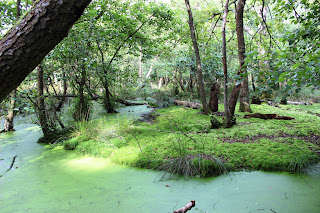The end of the Paralympics marked the end of the whole London 2012 celebration and the beginnings of the hand over to Rio 2016. As part of the Lord Mayor of London's celebrations there was a Rio style street carnival. Unlike the feather celebration mentioned in an earlier post, we did not stumble across this one but went specifically to see it. Our young friend Julian had been up visiting for the Olympics and we combined seeing him off with visiting the local Cherry Tree Wood Fair, where Aisha made a vegie monster - as you do. We ended up at Potters' Field again and browsing some of the markets set up there before heading down to the embankment to see the parade.

The carnival started late and the warm day quickly turned to a fairly cool night - which would have been challenging for some of the performers. We didn't stay until the end but did see a large part of the parade as it wound it's way across the Waterloo Bridge along the Thames and up to Millennium Bridge.










Brownsea island.
In August we went to Brownsea island to pay homage to Lord Baden Powell, the founder of Scouts and, indirectly, Girl Guides. Both the kids have heard stories abut BrownSea for many years in Scouts and Guides back in Australia. As part of a trip down to Osmington we decided to make the relatively short journey across to the island, the largest of eight islands in Poole Harbour off the Dorset coast.
Brownsea has quite a significant history beyond its more widely known scouting connection. The earliest recorded inhabitants date from the 9th century when a small chapel and hermitage were built by monks from Cerne Abbey near Dorchester. In 1015, no less a figure than King Canute led a Viking raid to the harbour and used Brownsea as a base to sack nearby Abbeys. Later, after his invasion of England, William the Conqueror gave the island as part of the local area to his half-brother, Robert de Mortain.
Following the dissolution of the monasteries, control of the island passed to the Crown. Recognising the strategic importance of the island in guarding the narrow entrance to the expanding port of Poole, Henry VIII had the island fortified in 1547. In 1576, his daughter, then Queen Elizabeth I, made a gift of Brownsea to one of her court favourites, Sir Christopher Hatton.
The island eventually ended up in private hands & served various purposes, including an unsuccessful attempt at establishing a fine china pottery there using the local clay. During WWII large flares were placed on the western end of the island to mislead Luftwaffe bombers away from the port of Poole. This saved Poole and Bournemouth from 1,000 tonnes of German bombs but resulted in the nearby deserted village of Maryland being destroyed.
Scouting on the island began on 1st August 1907. The then 50 year old Robert Stephenson Smyth Baden-Powell, 1st Baron Baden-Powell, Bt, OM, GCMG, GCVO, KCB held the first week long experimental scout camp on the island. 22 boys from differing social backgrounds took part in activities such as camping, observation, woodcraft, chivalry, lifesaving and patriotism. With the success of this camp, Powell was spurred on to publish 'Scouting for Boys' in 1908 and arrange further camps. The international scouting movement grew rapidly as a result. In the 1934 however, all public access on the island was forbidden by the island's owner, after a wild fire caused devastation. Burning for a week, much of the island was reduced to ashes. After the death of the owner, the island was taken over by the National Trust and a permanent Scout camp site was opened in 1963 by Olave Baden-Powell.




Brownsea is also one of the few places left in The UK where native red squirrels still live, having been overrun by the American grey squirrel - the ones that eat Mark's tulip bulbs.
 |
| Who on earth could possibly call them 'rats with fluffy tails' ??? |
Piddle.
As part of this trip we also went down to the coast to have a look at the amazingly formed Lulworth Cove (a result, in part, of the action of ancient ice age glacial melt water) and nearby Durdle Door on Dorset's Jurassic coast. Along the way we passed the river piddle. Really.
Brighton.
As one of the last outings of the school holidays ( yes all this happened in the holidays months ago !!!) Mark took the kids and a friend of theirs down to Brighton by train for the day. The last time we went there, in late winter 2010, it was to see Brighton Pavilion. It was a bit chilly, as the picture below suggests.
This time it was warmer, we browsed the antique shops, wandered 'The Brighton Lanes', threw money away in the penny arcades on the pier and even went swimming !

 |
| The traditional Strutt/ Eldrdige family pavlova. |
The last 'event' of the holidays was the long awaited arrival of our good friend Lyndall, who works in Iraq. She was on a much deserved rotation leave out of Baghdad and spent a few days with us enjoying the relative safety of London and some of its green and pleasant walks.






















No comments:
Post a Comment